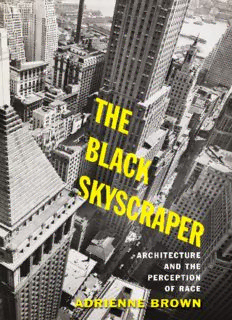
The Black Skyscraper: Architecture and the Perception of Race PDF
Preview The Black Skyscraper: Architecture and the Perception of Race
The Black Skyscraper This page intentionally left blank The Black Skyscraper Architecture and the Perception of Race ADRIENNE BROWN Johns Hopkins University Press Baltimore This book was brought to publication with the generous assistance of the University of Chicago. © 2017 Johns Hopkins University Press All rights reserved. Published 2017 Printed in the United States of Amer i ca on acid- free paper 2 4 6 8 9 7 5 3 1 Johns Hopkins University Press 2715 North Charles Street Baltimore, Mary land 21218 - 4363 www . press . jhu . edu Library of Congress Cataloging- in- Publication Data Names: Brown, Adrienne R., 1983– author. Title: The black skyscraper : architecture and the perception of race / Adrienne Brown. Description: Baltimore : Johns Hopkins University Press, 2017. | Includes bibliographical references and index. Identifiers: LCCN 2017007352| ISBN 9781421423838 (hardcover : alk. paper) | ISBN 9781421423845 (electronic) | ISBN 1421423839 (hardcover : alk. paper) | ISBN 1421423847 (electronic) Subjects: LCSH: Architecture and race— United States. | Skyscrapers— Social aspects— United States. Classification: LCC NA2543.R37 B76 2017 | DDC 720.1/03— dc23 LC rec ord available at https:// lccn . loc . gov / 2017007352 A cata log rec ord for this book is available from the British Library. Special discounts are available for bulk purchases of this book. For more information, please contact Special Sales at 410- 516- 6936 or specialsales@press. j hu. e du. Johns Hopkins University Press uses environmentally friendly book materials, including recycled text paper that is composed of at least 30 percent post- consumer waste, whenever pos si ble. HATS, where do you belong? what is under you? On the rim of a skyscraper’s forehead I looked down and saw: hats: fifty thousand hats: Swarming with a noise of bees and sheep, c attle and waterfalls, Stopping with a silence of sea grass, a silence of prairie corn. Hats: tell me your high hopes. — Carl Sandburg, “Hats,” 1920 This page intentionally left blank contents Acknowl edgments ix 1 Introduction: Race in Three Dimensions 1 2 Architecture and the Visual Fate of Whiteness 35 3 Miscegenated Skyscrapers and Passing Metropolitans 82 4 The Black Skyscraper 122 5 Feeling White in the Darkening City 158 Epilogue: From Skyscraper to Suburb 197 Notes 203 Works Cited 237 Index 255 This page intentionally left blank acknowle dgments This book exists because of the many p eople who have extended kindnesses, support, care, critique, generosity, and enthusiasm to both it and me. My disserta- tion advisers at Prince ton University— Diana Fuss, Bill Gleason, and Valerie Smith— were the first to believe in the idea that there was more to the narrative history of the skyscraper than even I knew at the time. Each has expanded my idea of not only what it means to be a scholar of the built environment and of lit- er a ture but also what it is to be a scholar in general. Thank you. Daphne Brooks taught me to study both what sparks my intellectual curiosity and the t hings I love. Broad thanks to the Prince ton En glish Department, the Program in American Studies, and the former Center for African American Studies. Thanks to Anne Cheng for her support and cheer. From the Prince ton diaspora, I also thank Amelia Worsley, Briallen Hopper, Jess Row, Alicia Christoff, Anne Hirsch Moffitt, Anthony Petro, Alden Young, J. K. Barret, Michelle Coghlan, Ivan Ortiz, and W ill Evans for their camaraderie, assistance, and joy in the pro cess of writing this book. Much love to Lindsay Reckson and Nadia Ellis for their brilliant minds and beautiful style, on and off the page. Gratitude to Wendy A. Lee and Jacky Shin for being game to read anything at the drop of a hat and making me laugh at the same time. Every one told me when I moved to Chicago that it was the perfect place to be while finishing this book because of its storied skyscraper history. But it is the people within this city who have proved to be far more impor tant to its comple- tion. Thanks to Lauren Berlant for being a generous colleague but also a dear friend— thanks for helping me hold this thing up. Ken Warren’s support for this proj ect as it shifted foci was im mense. I also want to thank my two depart- ment chairs during the course of writing this book, Elaine Hadley and Frances Ferguson. I couldn’t have asked for better shepherds. I thank the entire En glish Department at the University of Chicago, as well as the Center for Race, Politics,
Description: